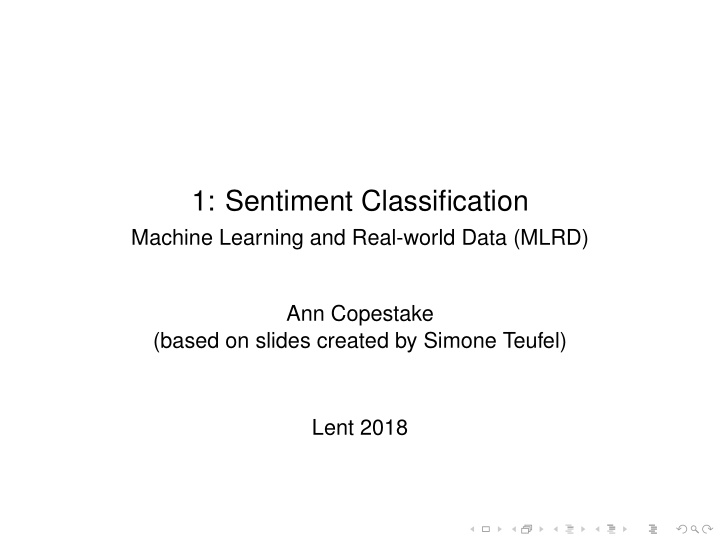



1: Sentiment Classification Machine Learning and Real-world Data (MLRD) Ann Copestake (based on slides created by Simone Teufel) Lent 2018
This course: Machine Learning and Real-world Data (MLRD) Three Topics: Classification: sentiment classification – thousands of movie reviews. Sequence analysis: proteins – hundreds of amino acid sequences. Network analysis: social networks — thousands of users and links between them. Different types of machine learning: straightforward approaches you can implement quickly. Emphasis on methodology: relevant for all approaches. Practical-based, each session starts with a short lecture introducing the main concepts.
Computer Science as an empirical subject The style of solving tasks in this course is empirical . You will start from a hypothesis or an idea which you will test. Then you perform some manipulations on your data. You observe and record the results. You need a lab book to record your manipulations, observations and measurements. physical book or electronic record
Topic 1: Evaluative language and sentiment classification IMDb (= Internet Movie Data Base) has about 4.7 million titles ( http://www.imdb.com/pressroom/stats/ ). Reviews: written in natural language by the general public. Sentiment classification — the task of automatically deciding whether a review is positive or negative, based on the text of the review. Standard task in Natural Language Processing (NLP) .
IMDb
Review sentiment
Review sentiment
Review sentiment
Review sentiment
From a good review ... He’s incredible in fights. ... Also his relationship with Irons, who plays Alfred, is just wonderful in general. Irons was exceptional in the role.
A bad review This movie tries so hard... It completely fails on every single level. The movie is tedious and boring with characters that I just did not care about at all. ...
Experiments with movie reviews Lots of possible NLP experiments . . . Today: use data about individual words to find sentiment. Sentiment lexicon lists over 8000 words as positive or negative. Hypothesis: a review that contains more positive than negative words is positive overall.
Experiments with movie reviews Lots of possible NLP experiments . . . Today: use data about individual words to find sentiment. Sentiment lexicon lists over 8000 words as positive or negative. Hypothesis: a review that contains more positive than negative words is positive overall. word=foul intensity=weak polarity=negative word=mirage intensity=strong polarity=negative word=aggression intensity=strong polarity=negative word=eligible intensity=weak polarity=positive word=chatter intensity=strong polarity=negative Note: a lexicon is a list of words with some associated information.
Sentiment lexicon words in the good review ... He’s incredible in fights. ... Also his relationship with Irons, who plays Alfred, is just wonderful in general. Irons was exceptional in the role. incredible positive wonderful positive exceptional positive
Sentiment lexicon words in the bad review This movie tries so hard... It completely fails on every single level. The movie is tedious and boring with characters that I just did not care about at all. ... try negative fail negative tedious negative boring negative care positive
But it doesn’t always work . . . This movie tries so hard... The ending should be exciting and fun and amazing.. and it just... wasn’t. It completely fails on every single level. The movie is tedious and boring with characters that I just did not care about at all. ... try negative exciting positive fun positive amazing positive fail negative tedious negative boring negative care positive
Evaluation No system predicts sentiment perfectly. How do we know the extent to which we’ve got it right? The author of the review told us the truth explicitly via a star rating (that’s why NLP researchers like movie reviews). The rating has been extracted along with the review text. We will calculate a metric called A (accuracy).
Star rating
Accuracy The number of correct decisions c divided by total decisions (correct plus incorrect ( i )): c A = c + i This metric is called A (accuracy). We know which decisions are “correct” because we can use the star rating as our definition of truth.
Tokenisation: getting the words out Your code will look up words from your review document in the lexicon. So it needs to divide the text into words. Splitting on whitespace is not enough. Words at the beginning of a sentence appear in upper case. Words occurring before and after punctuation may be directly attached to the punctuation. and many other things . . . Your code will use a well-known basic tokeniser to split the text into individual words. Note: type vs token (see ‘Further notes’ in Session 2)
Your tasks for today Task 1: explore the review data (1800 documents) explore the sentiment lexicon write a program that tests the sentiment lexicon approach write a program for using the star ratings to evaluate how well your program is doing and keep a record of what you do
Example lab book page
Practicalities 16 lectures (approx 25 minutes) [Mon, Fri] 16 demonstrated sessions in the Intel Lab: from immediately after lecture to 4:30pm [Mon, Fri] 12 tasks and 4 catch-up sessions 12 ticks: you should get them all Most tasks have automated tester: pass this first! Ticking during demonstrated sessions, queue on whiteboards. Lots more on Moodle . . .
Recommend
More recommend